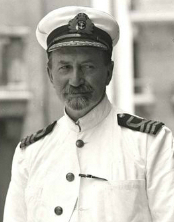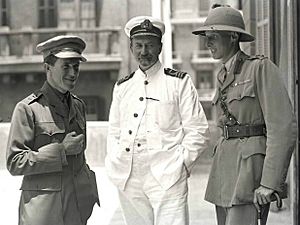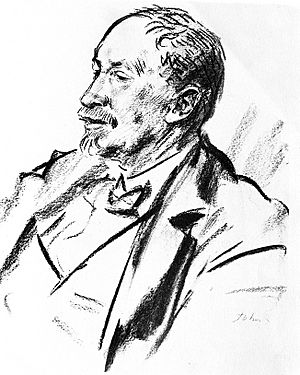David George Hogarth facts for kids
Quick facts for kids
David George Hogarth
|
|
|---|---|

Commander Hogarth in 1918
|
|
| Born | 23 May 1862 Barton-upon-Humber, Lincolnshire, England
|
| Died | 6 November 1927 (aged 65) Oxford, Oxfordshire, England
|
| Nationality | British |
| Alma mater | Oxford University |
| Spouse(s) | Laura Violet (Hogarth) Uppleby |
| Scientific career | |
| Fields | Archaeology, classics, education, journalism, fund directorship, museum curatorship, intelligence operations and directorship, diplomacy |
| Institutions |
|
| Influences | Arthur Evans |
| Influenced | T. E. Lawrence |
David George Hogarth (born May 23, 1862 – died November 6, 1927) was a British archaeologist and expert. He was known for his work with T. E. Lawrence and Arthur Evans. From 1909 to 1927, he was in charge of the Ashmolean Museum, Oxford.
During the First World War, Hogarth joined the Royal Naval Volunteer Reserve. He worked for the Naval Intelligence Division. In 1916, he was the acting head of the Arab Bureau. He also helped deliver an important message known as the Hogarth message.
Contents
Early Life and School
David George Hogarth was born in Barton-upon-Humber, England. His father, George Hogarth, was a vicar, which is a type of priest. David had a younger sister named Janet E. Courtney, who became an author.
Hogarth went to Winchester College from 1876 to 1880. He called it "our oldest Public School." In 1881, he started studying at Magdalen College, Oxford. He was a very good student, earning top grades. He finished his first degree in 1885.
His Career and Discoveries
In 1886, Hogarth became a Fellow at Magdalen College, Oxford. This meant he was a senior member of the college. From 1887 to 1907, he traveled a lot. He went on archaeological digs in many places. These included Cyprus, Crete, Egypt, Syria, Melos, and Ephesus. In Crete, he excavated sites like Zakros and Psychro Cave.
From 1897 to 1900, Hogarth was the director of the British School at Athens. This school helps students learn about ancient Greece. Later, in 1909, he became the keeper of the Ashmolean Museum in Oxford. He stayed in this important role until he passed away in 1927.
Hogarth During World War I

In 1915, during the First World War, Hogarth joined the Royal Naval Volunteer Reserve. He was given the rank of lieutenant commander. He worked in the Geographical Section of the Naval Intelligence Division. This group gathered information for the British Navy.
For a time in 1916, Professor Hogarth was the acting director of the Arab Bureau. This was a British intelligence office in Cairo. He worked closely with T. E. Lawrence, who was also known as Lawrence of Arabia. Together, they helped plan the Arab Revolt, where Arab forces fought against the Ottoman Empire.
After the war, in June 1919, Hogarth returned to Oxford. He continued his work at the Ashmolean Museum. From 1925 to 1927, he was the president of the Royal Geographical Society. This society promotes geographical science.
Family Life

On November 7, 1894, David Hogarth married Laura Violet Uppleby. She was 26 years old, and he was 32. They had one son, William David Hogarth. Their granddaughter, Caroline Barron, became a historian.
In 1926, Hogarth's health started to get worse because of a heart problem. He passed away on November 6, 1927, at his home in Oxford. He was 65 years old.
Awards and Honours
David Hogarth received many awards for his work.
- In 1896, he became a Fellow of the Royal Geographical Society (FRGS).
- In 1905, he was elected a Fellow of the British Academy (FBA). This is a high honour for experts in humanities and social sciences.
- In 1917, the Sultan of Egypt made him a Commander of the Order of the Nile. He also received the Founder's Medal from the Royal Geographical Society.
- In 1918, he was made a Companion of the Order of St Michael and St George (CMG) for his efforts during World War I.
- In 1919, he received the Order of Nahda from Hussein bin Ali, who was the Sharif of Mecca.
See also

